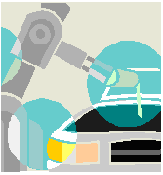|
By : Jim Pinto, When it comes to robots, reality still lags science fiction. But the confluence of several advanced technologies is bringing the age of robotics ever nearer. Today’s robots are smaller, cheaper, more practical and cost-effective and are chalking up major gains in the automation world.
Automation World, February 2006
|
 When it comes to robots, reality still lags science fiction. But the confluence of several advanced technologies is bringing the age of robotics ever nearer. Today’s robots are smaller, cheaper, more practical and cost-effective and are chalking up major gains in the automation world.
When it comes to robots, reality still lags science fiction. But the confluence of several advanced technologies is bringing the age of robotics ever nearer. Today’s robots are smaller, cheaper, more practical and cost-effective and are chalking up major gains in the automation world.
At the end of 2005, there were about 1 million industrial robots globally, with almost half that number in Japan and just 15 percent in the United States. In spite of its low-cost labor image, China is rapidly adopting robotics systems to increase competitiveness. A couple of decades ago, 90 percent of industrial robots were used in car manufacturing, typically on assembly lines doing a variety of repetitive tasks such as spray-painting, cutting and welding. Today, less than 50 percent are in automobile plants, with the rest spread out among other factories, laboratories, warehouses, energy plants, hospitals and many other industries. With some 100,000 robots already in use, U.S. automotive manufacturing companies continue to utilize and develop intelligent robotics to provide significant new strategic options. Some of the “smartest” robots are not in manufacturing—they are used as space explorers, remotely operated surgeons and other exotic applications. But these other applications show what might be possible on production floors, far beyond yesterday’s machinery concepts. With the rapidly increasing processing power and advanced intelligence, robots are dramatically increasing their potential as flexible automation tools. Robotic technology is converging with a wide variety of complementary technologies—machine vision, force sensing (touch), speech recognition and advanced mechanics. This results in exciting new levels of functionality for jobs that were never before considered practical for robots. The introduction of robots with integrated vision and touch dramatically changes the speed and efficiency of new production and delivery systems. Robots have become so accurate that they can be applied where manual operations are no longer a viable option. The biggest change in industrial robots is that they will evolve into a broader variety of structures and mechanisms. In many cases, configurations that evolve into new automation systems won’t be immediately recognizable as robots. For example, robots that automate semiconductor manufacturing already look quite different from those used in automotive plants. Technology leapYou may recall the March 2004 DARPA robot race that ended as a bust—no one won the coveted $1 million prize. In fact, not one participant went much beyond a just a few miles, and many fizzled out just a short distance from the starting line.The race was held again Oct. 8-9, 2005, and DARPA doubled the prize. They designed a much more difficult course, predicting that several contestants would complete the race, given the level of technology demonstrated in qualifying events. And indeed, there was a dramatic technology leap; five entries crossed the finish line and the fastest was judged the winner. After some false starts in automation manufacturing a couple of decades ago, robotics technology has not been on venture capital funding lists. But now, after the DARPA-race success, and with the announcement of a $115 million initial public offering of stock by iRobot (manufacturer of the Roomba home-vacuum as well as several robots for military applications), robot technology is starting to attract VC attention. This is a key indicator that strong growth in robotics is emerging. The day will come when there are more programmable tooling kinds of robots than all of the traditional robots that exist in the world today. There is an enormous change on the horizon; the potential is significant, because robots offer not only improved cost-effectiveness, but also advantages and operations that have never been possible before. 
|
Return to Index of all JimPinto Writings

 Return to JimPinto.com HomePage
Return to JimPinto.com HomePage
If you have ideas or suggestions to improve this site, contact: webmaster@jimpinto.com
Copyright 2003 : Jim Pinto, San Diego, CA, USA
